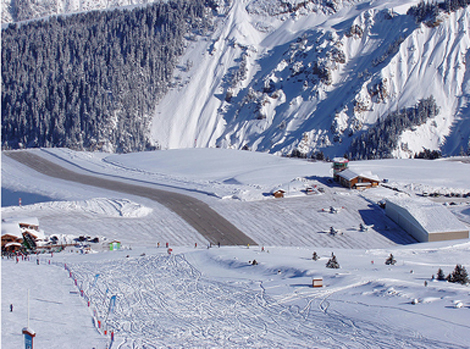
Popular Mechanics has a photo gallery of eighteen unusual airports around the world, including the above airport of Courchevel, a town in the French Alps. The runway has a hill the middle with a 18.5% grade. Landing on this airstrip is so difficult that it requires a special pilot’s certification.
Link via Glenn Reynolds| Photo: Popular Mechanics
1: Kansai International Airport
Osaka, Japan
(Photograph by Tdk)
Background:
Land is a scarce resource in Japan, so engineers headed roughly 3 miles offshore into Osaka Bay to build this colossal structure. Work on the manmade island started in 1987, and by 1994 jumbo jets were touching down. Travelers can get from the airport to the main island of Honshu via car, railroad or even a high-speed ferry. Why It's Unique:
Kansai's artificial island is 2.5 miles long and 1.6 miles wide—so large that it's visible from space. Earthquakes, dangerous cyclones, an unstable seabed, and sabotage attempts from protestors are just some of the variables engineers were forced to account for. As impressive as the airport is, Stewart Schreckengast, a professor of aviation technology at Purdue University and a former aviation consultant with MITRE, cautions that climate change and rising sea levels pose a very real threat to the airport's existence. "When this was built, [engineers] probably didn't account for global warming," he says. "In 50 years or so, this might be underwater." 2: Gibraltar Airport
Gibraltar
Background:
Between Morocco and Spain sits the tiny British territory of Gibraltar. Construction of the airport dates back to World War II, and it continues to serve as a base for the United Kingdom's Royal Air Force, though commercial flights land on a daily basis. Why It's Unique:
Winston Churchill Avenue, Gibraltar's busiest road, cuts directly across the runway. Railroad-style crossing gates hold cars back every time a plane lands or departs. "There's essentially a mountain on one side of the island and a town on the other," Schreckengast says. "The runway goes from side to side on the island because it's the only flat space there, so it's the best they can do. It's a fairly safe operation as far as keeping people away," he says, "It just happens to be the best place to land, so sometimes it's a road and sometimes it's a runway." 3: Madeira International Airport
Maderia, Portugal
Background:
Madeira is a small island far off the coast of Portugal, which makes an airport that is capable of landing commercial-size aircraft vital to its development. This airport's original runway was only about 5000 feet long, posing a huge risk to even the most experienced pilots and limiting imports and tourism. Why It's Unique:
Engineers extended the runway to more than 9000 feet by building a massive girder bridge atop about 200 pillars. The bridge, which itself is over 3000 feet long and 590 feet wide, is strong enough to handle the weight of 747s and similar jets. In 2004, the International Association for Bridge and Structural Engineering selected the expansion project for its Outstanding Structure Award, noting that the design and construction was both "sensitive to environmental and aesthetic considerations." 4: Don Mueang International Airport
Bangkok, Thailand
Background:
From a distance Don Mueang International looks like any other midsize airport. However, smack-dab in the middle of the two runways is an 18-hole golf course. Why It's Unique:
Schreckengast, who has worked on consulting projects at this airport, says one of the major problems is that the only taxiways were located at the end of the runways. "We recommended that they build an additional taxiway in the middle, from side to side, and they said ‘absolutely not, that will take out a green and one fairway.'" The airport and the course were originally an all-military operation, but have since opened up to commercial traffic. Security threats, however, have limited the public's access to the greens. 5: Ice Runway
Antarctica
Background:
The Ice Runway is one of three major airstrips used to haul supplies and researchers to Antarctica's McMurdo Station. As its name implies, there are no paved runways here—just long stretches of ice and snow that are meticulously groomed. Why It's Unique:
There is no shortage of space on the Ice Runway, so super-size aircraft like the C-130 Hercules and the C-17 Globemaster III can land with relative ease. The real challenge is making sure that the weight of the aircraft and cargo doesn't bust the ice or get the plane stuck in soft snow. As the ice of the runway begins to break up, planes are redirected to Pegasus Field or Williams Field, the two other airstrips servicing the continent. 6: Congonhas Airport
Sao Paulo, Brazil
(Photograph by Mariordo)
Background:
Most major cities have an airport, but rarely are they built just 5 miles from the city center, especially in metropolises like Sao Paulo. Congonhas' close proximity to downtown can be attributed in part to the fact that it was completed in 1936, with the city experiencing rapid development in the following decades. Why It's Unique:
While having an airport only 5 miles from the city center may be a convenience for commuters, it places a strain on both pilots and air traffic control crews. "It becomes a challenge in terms of safety to just get the plane in there," Schreckengast says. "Then you throw on noise restrictions and these terribly awkward arrival and departure routes that are needed to minimize your noise-print and it becomes quite challenging for pilots." Fortunately, Sao Paulo's many high-rise buildings are far enough away from the airport that they aren't an immediate obstacle for pilots landing or taking off. 11: Barra Airport
Barra, Scotland
(Photograph by Sue Johnson)
Background:
Planes bound for the island of Barra, located off Scotland's west coast, have used the beach as a makeshift runway since the 1930s. Despite the lack of paved runways on the island, the airport still boasts a modern control tower that's responsible for handling more than 1000 incoming and departing flights per year. Why It's Unique:
When the tide comes in at Barra, the runway disappears, forcing flights to be scheduled around the movement of the ocean. Landing on the beach, while novel, has drawbacks. "The little pieces of sand and salt really eat up the bearings and can jam moving parts of the airplane," Schreckengast says. "In a lot of places where they have unsurfaced runways like this, special maintenance procedures are required." 12: Hong Kong International Airport
Chek Lap Kok, Hong Kong
Background:
Hong Kong's original airport, Kai Tak, was surrounded by high-rise buildings and residential areas, with a runway that jutted into the water. Officials knew they needed a replacement, especially to facilitate the enormous amount of cargo passing through the region, so they built this 3.2-sqaure-mile island. Construction started in 1991, and involved merging two smaller islands together with reclaimed land. Why It's Unique:
What makes Hong Kong International Airport stand out from other island-based airports is the fact that there is a luxury golf course and massive expo center within walking distance from the runway. The airport consistently ranks as one of the busiest cargo hubs in the world—3.35 million metric tons of cargo passed through it in 2009—so amenities like the Sky City Nine Eagles Golf Course cater to the constant stream of professionals passing through. A quick round of nine holes at night costs about $60.13: Toncontin International Airport
Tegucigalpa, Honduras
(Photograph by Enrique Galeano Morales)
Background:
Near the center of Honduras' capital city, Tegucigalpa, is the notorious Toncontin International Airport, which has been the subject of scrutiny following several accidents, including a 2008 crash that killed five. The airport opened in 1934, an era when planes were less powerful and didn't require such lengthy runways. Why It's Unique:
Toncontin's runway is just over 7000 feet long and situated in a valley surrounded by mountains. Despite the stubby runway, planes as large as 
14: Qamdo Bangda Airport
Qamdo, Tibet
Background:
This is the world's highest airport, perched more than 14,000 feet above sea level. Even more impressive than the airport's altitude, perhaps, is the nearly 3.5-mile-long runway. However, as reported by The Guardian in January, 2010, China is slated to start construction next year on a new airport in Tibet, which will be a measly 2 meters higher than Bangda. Why It's Unique:
Having a runway that's the length of 61 football fields may seem a tad excessive, but Schreckengast says that long runways are crucial to making safe landings at higher altitudes. "When you go up to these higher-elevation airports, then your approach speed, landing speed and takeoff speeds will need a higher ground speed," he says. "At sea level, where your approach speed is 150 mph, it may take 5000 feet of runway to stop. At 14,000 feet your approach speed is still 150, but maybe it takes 10,000 feet to stop." 15: Dammam King Fahd International Airport
Dammam, Saudi Arabia
Background:
King Fahd International is the largest airport in the world in terms of landmass, sprawling over 300 square miles of desert. The airport is so enormous that it is actually about 11 square miles larger than Saudi Arabia's neighbor, Bahrain. Why It's Unique:
Among the many features that make this airport stand out is a mosque large enough to take in thousands of people. Also notable, though not entirely uncommon in Saudi Arabia, is the Royal Terminal, which is designed to service the Royal Family and is outfitted with an elegant reception hall and a pressroom. One of the major obstacles during the construction of the airport, Schreckengast says, was the lack of fresh water to mix concrete. 16: Denver International Airport
Denver, Colorado
Background:
Denver International's 53 square miles of land makes it the largest airport in North America. Opened in 1995, the facility is loaded with modern features, including a 16,000-foot-long runway capable of handling Airbus A380s. Why It's Unique:
"There's not many ways to make money off the excess land," Schreckengast says, "unless you can become self-sufficient." The designers of this airport were hoping to do just that, launching major green initiatives such as a 9200-panel solar farm. The airport says the solar farm produces 3 million kilowatt-hours of electricity per year, or about half the energy required to power the terminal for a year. Additionally, at the end of 2009, the airport built another photovoltaic system that is responsible for powering the fuel-storage and distribution facility. 17: Macau International Airport
Macau
Background:
Macau, a former colony of Portugal off the coast of China, lacked accommodations for large aircraft until this airport opened in 1995. The strip of reclaimed land is large enough for 747s to land safely on. Why It's Unique:
Like Kansai and Hong Kong, engineers had to rely on reclaimed land to build an airport in this densely populated area. "In the Asia Pacific region you have a lot of mountains and then shoreline where the people live. There are not many options of where you can build an airport, so in a lot of cases you're either building an island or extending an existing one," Schreckengast says. A set of highways links the runway with the small island of Taipa, where the air traffic control tower and main terminal are located. 18: Copalis State Airport
Grays Harbor County, Washington
Background:
One way to get to Washington's Griffiths-Priday Ocean State Park is to land on this 4500-foot-long strip of beach. The runway is located between the mouth of the Copalis River and a barrier of rocks, with orange reflective markers at both ends to help guide pilots to a safe landing. Why It's Unique:
The Washington State Department of Transportation urges incoming pilots to do a fly-over before landing to make sure the runway is free of debris. The Department of Transportation also notes that pilots should aim for dark, wet sand, which is more stable to land on than light-colored, soft sand. As with other beach-based landing areas, Copalis State Airport is submerged every time the tide rolls in. Pilots considering spending some time on the beach should make sure to park their aircraft above the high tide mark in order to ensure that their planes aren't taken out to sea. 
























0 comments:
Post a Comment